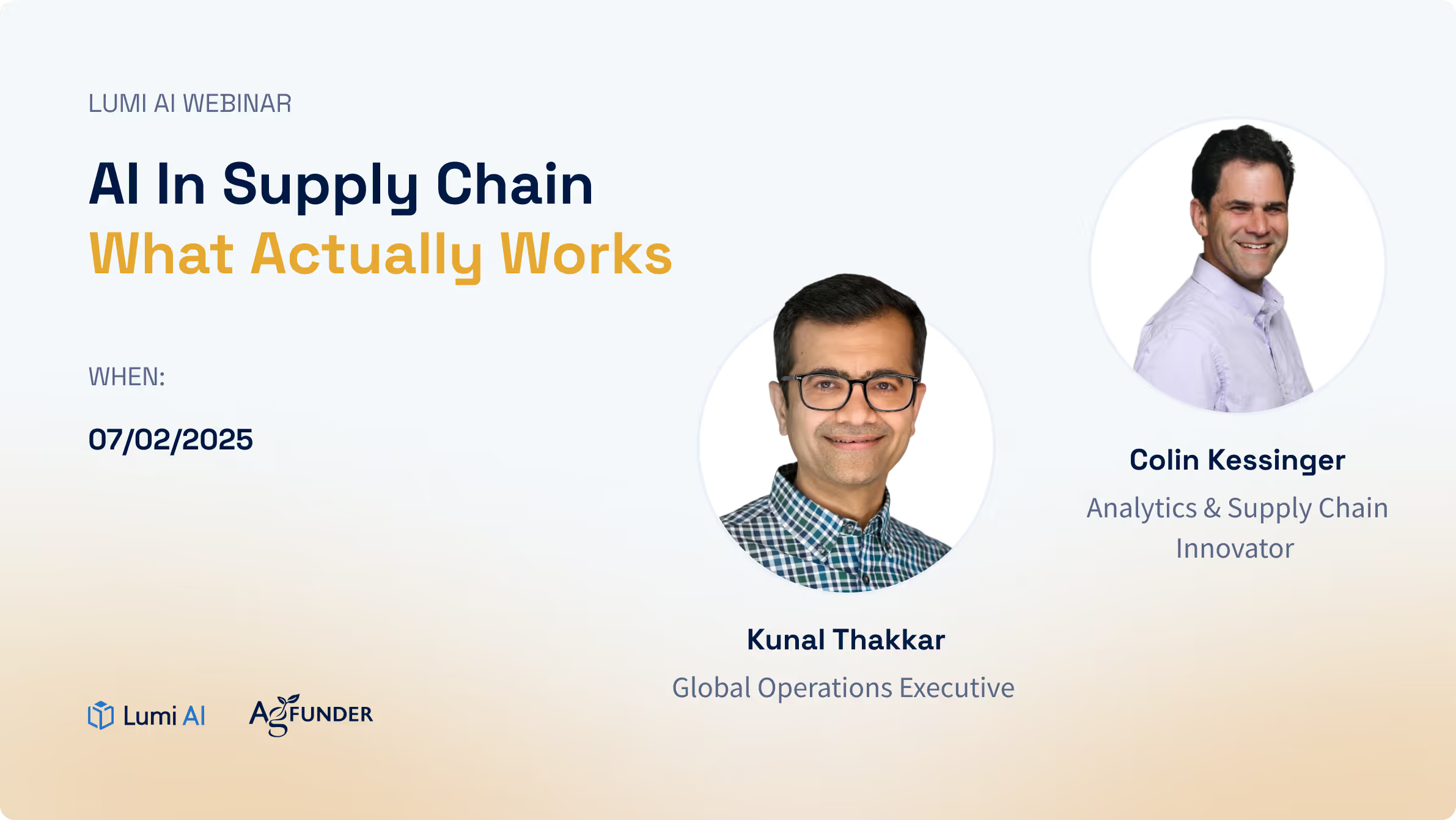Back to blog
Back to Case Studies
AI-Driven Category Management & Merchandising



Category Management & Merchandising Webinar
In this session, industry experts from Lumi AI, BCG, and Daisy Intelligence explore how Generative AI is reshaping category management and merchandising. The discussion covers real-world use cases across pricing, promotions, assortment, and decision augmentation—focusing on measurable ROI, halo optimization, and change management strategy.
Key speakers include
• Ibrahim Ashqar (CEO, Lumi AI)
• Trap Yates (Managing Director & Partner, BCG)
• Gary Saarenvirta (Former CEO, Daisy Intelligence)
These leaders share firsthand lessons on how AI is being embedded in category workflows, what organizational shifts are required for success, and how to overcome the change management traps that stall transformation.
Webinar Key Takeaways
✅ Change management is critical. AI delivers real ROI in category management, but the biggest barrier to success is organizational, not technical.
✅ AI must be embedded into workflows. Unlocking value means rethinking roles, tools, and incentives - not just adopting new algorithms.
✅ Start small, prove value, then scale. The best pilots focus on adoption and trust-building, not just model accuracy.
What This Webinar Uncovered
AI in category management isn't just about automating reports or saving time. It's about transforming how decisions are made. This session dives into:
- Using Generative AI to improve decision quality in pricing, assortment, and promotions
- Leveraging AI and reinforcement learning to optimize halo-based product selection
- Embedding AI into workflows without overhauling processes
- Why organizational change, not algorithms, is the real barrier
Trap Yates (BCG), Gary Saarenvirta (formerly Daisy Intelligence), and Ibrahim Ashqar (Lumi AI) offer a grounded look at how leaders are deploying AI to capture top-line growth and margin gains.
The 10-20-70 Rule: It’s Not About the Tech
As Trap Yates explains, only 10% of AI transformation is algorithmic. 20% is data and platform. The remaining 70%? People, process, and organizational change.
That’s why many retailers stall at pilot phase. AI isn't embedded into workflows; it sits beside them, unadopted. Success comes from rethinking KPIs, change management, and executive ownership.
"Without embedding AI into how merchants work day-to-day, it collects dust." – Trap Yates
Halo Thinking: Driving Total-Store Growth
Gary Saarenvirta illustrates how retailers can drive 3–5% sales growth by promoting high-halo products like ground beef instead of low-halo items like diapers. This isn't about individual item margin; it's about total basket impact.
By targeting halo drivers, retailers can boost transactions and maintain margins without aggressive discounting.
"Nobody eats just raw ground beef. The halo of ground beef increases the total basket of pasta, sauce, cheese, and wine. Identifying halo products and basket size drivers is how to drive real margin impact."
Gen AI as Interface: Making Math Actionable
Category managers aren’t data scientists. They need tools that work like colleagues, not codebases. That’s where Gen AI shines.
In one case study, Lumi helped a retail team surface 38 high-elasticity items where a > 5% price drop doubled volume. This wasn't about running a model manually. It was a conversation:
The assistant generated code, analyzed 100,000+ SKUs, and returned a targeted shortlist, enabling faster, smarter action.
"Merchants don't want to click through reports. They want to ask a question and get a strategic answer." – Ibrahim Ashqar
Data Hierarchies and the Role of Gen AI in Structuring Complexity
Both Gary and Trap emphasize that clean product hierarchies are foundational to effective AI. But merchants rarely work with analytically sound hierarchies. Gen AI can help bridge that gap—structuring SKUs, naming need states, and making complex models understandable.
"We had names like '$1.59 Yogurt Dannon Blueberry.' No one could use that. Gen AI helps make item categories human-readable." – Gary Saarenvirta
Breaking Siloed Decision-Making
Halo analytics expose a fundamental flaw in retail org design: category silos. If beef and pasta are promoted by different teams, halo insights get lost.
Trap calls for new decision structures, portfolios of complementary categories, shared KPIs, and revised incentive systems that prioritize total-store outcomes over isolated wins.
"The beef merchant might need to take a hit for the pasta team to win. AI shows why. But leadership must back that with comp changes."
AI as a Top-Line Growth Engine
While time savings matter, the real ROI is in incremental sales and margin. Trap puts it plainly:
AI should be aimed at top-line and net income growth, not just operational efficiency. That requires trust, transparency, and leadership fluency in AI's value.
"Taking hours out of a merchant's week is great. Adding 100bps to gross margin? That's game-changing."
From Pilot to Scale: Adoption Lessons
A common theme: don’t start with a black box. Start with transparency. Let merchants compare their historical plans with AI recommendations, then gradually hand over the reins.
In-market pilots aren't just about performance, they're about change management.
"The most dangerous moment is after the first use. You need to manage that disillusionment." – Trap Yates
Executive Fluency: AI Requires More Than Sponsorship
Fewer than 30% of companies have CEOs driving the AI agenda. That’s a problem. Leaders need to:
- Understand business-ready data, not just say "we need data"
- Explain objective functions ("Why AI?")
- Address ethics, explainability, and organizational impact
"Executives often have a one-line answer for AI. It needs to survive four questions deep." – Trap Yates
Missed the Session?
You can still watch the full recording or view the transcript to learn how innovative teams are embedding AI into category management to move from static planning to dynamic, data-driven decisioning.
At Lumi, we’re helping merchandising and category teams shift from siloed data and reports to actionable insights. If you're exploring how retail AI or predictive analytics could work inside your merchandising operations, let’s talk.

Make Better, Faster Decisions.






